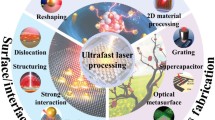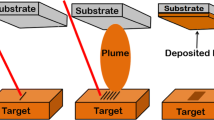Abstract
Femtosecond laser has been widely utilized for modification of crystal structure to achieve desired functions. So far, however, the effect of crystallographic orientation on the induced structure by femtosecond laser processing has yet been comprehensively studied. The present work is undertaken in an attempt to fill this gap in our knowledge. To this end, commercial-purity Si is used as a target material and high-resolution transmission electron microscopy as well as electron backscatter diffraction are applied to examine the irradiation-induced microstructural changes. The structural response of the pulsed material is found to be principally influenced by the crystallographic orientation of the target surface. Specifically, at the surface orientation close to {111}, a pronounced amorphization effect is observed whereas no disordered material is detected at the orientations close to {100}. This phenomenon could be explained by the lowest crystallization speed required by the (111) surface due to its smallest surface energy. Compared with nanosecond laser, non-thermal melting induced by femtosecond laser induces mild thermal gradient and favors recrystallization.

taken from polycrystalline Si irradiated at laser peak-fluence of 0.99 J/cm2


taken from single-crystalline Si with the (111) surface


taken from polycrystalline Si irradiated at laser peak-fluence of 0.99 J/cm2

Similar content being viewed by others
Notes
Some inconsistency in spacing between the laser-irradiated spots seen in Fig. 1 is likely due to the perspective effect associated with the sample tilting in the SEM.
References
J. Jia, M. Li, C.V. Thompson, Amorphization of silicon by femtosecond laser pulses. Appl. Phys. Lett. 84, 3205–3207 (2004). https://doi.org/10.1063/1.1719280
Y. Izawa, Y. Setuhara, M. Hashida, M. Fujita, Y. Izawa, Ablation and amorphization of crystalline Si by femtosecond and picosecond laser irradiation. Jpn. J. Appl. Phys. 45, 5791 (2006). https://doi.org/10.1143/JJAP.45.5791
Y. Izawa, Y. Izawa, Y. Setsuhara, M. Hashida, R. Sasaki, H. Nagai, M. Yoshida, Ultrathin amorphous Si layer formation by femtosecond laser pulse irradiation. Appl. Phys. Lett. 90, 044107 (2007). https://doi.org/10.1063/1.2431709
M. Rini, N. Dean, J. Itatani, Y. Tomioka, R.W. Schoenlein, A. Cavalleri, Control of the electronic phase of a manganite by mode-selective vibrational excitation. Nature 449, 72–74 (2007). https://doi.org/10.1038/nature06119
S. Wall, D. Wegkamp, L. Foglia, K. Appavoo, J. Nag, R.F. Haglund, M. Wolf, Ultrafast changes in lattice symmetry probed by coherent phonons. Nat. Commun. 3, 1–6 (2012). https://doi.org/10.1038/ncomms1719
M. Hase, P. Fons, K. Mitrofanov, A.V. Kolobov, J. Tominaga, Femtosecond structural transformation of phase-change materials far from equilibrium monitored by coherent phonons. Nat. Commun. 6, 8367 (2015). https://doi.org/10.1038/ncomms9367
T.H.R. Crawford, G.A. Botton, H.K. Haugen, Crystalline orientation effects on conical structure formation in femtosecond laser irradiation of silicon and germanium. Appl. Surf. Sci. 256, 1749–1755 (2010). https://doi.org/10.1016/j.apsusc.2009.09.107
X. Sedao, C. Maurice, F. Garrelie, J.P. Colombier, S. Reynaud, R. Quey, F. Pigeon, Influence of crystal orientation on the formation of femtosecond laser-induced periodic surface structures and lattice defects accumulation. Appl. Phys. Lett. 104, 171605 (2014). https://doi.org/10.1063/1.4874626
J.M. Liu, Simple technique for measurements of pulsed Gaussian-beam spot sizes. Opt. Lett. 7, 196–198 (1982). https://doi.org/10.1364/OL.7.000196
A.G. Cullis, N.G. Chew, H.C. Webber, D.J. Smith, Orientation dependence of high speed silicon crystal growth from the melt. J. Cryst. Growth. 68, 624–638 (1984). https://doi.org/10.1016/0022-0248(84)90469-X
J.A. Yater, M.O. Thompson, Orientation dependence of laser amorphization of crystal Si. Phys. Rev. Lett. 63, 2088 (1989). https://doi.org/10.1103/PhysRevLett.63.2088
S.K. Sundaram, E. Mazur, Inducing and probing non-thermal transitions in semiconductors using femtosecond laser pulses. Nat. Mater. 1, 217–224 (2002). https://doi.org/10.1038/nmat767
M.Z. Mo, Z. Chen, R.K. Li, M. Dunning, B.B.L. Witte, J.K. Baldwin, A.H. Reid, Heterogeneous to homogeneous melting transition visualized with ultrafast electron diffraction. Science 360, 1451–1455 (2018). https://doi.org/10.1126/science.aar2058
L. Jiang, A.D. Wang, B. Li, T.H. Cui, Y.F. Lu, Electrons dynamics control by shaping femtosecond laser pulses in micro/nanofabrication: modeling, method, measurement and application. Light-Sci. Appl. 7, 17134–17134 (2018). https://doi.org/10.1038/lsa.2017.134
J. Bonse, K.W. Brzezinka, A.J. Meixner, Modifying single-crystalline silicon by femtosecond laser pulses: an analysis by micro Raman spectroscopy, scanning laser microscopy and atomic force microscopy. Appl. Surf. Sci. 221, 215–230 (2004). https://doi.org/10.1016/S0169-4332(03)00881-X
J. Bonse, All-optical characterization of single femtosecond laser-pulse-induced amorphization in silicon. Appl. Phys. A: Mater. Sci. Process. A 84, 63–66 (2006). https://doi.org/10.1007/s00339-006-3583-3
Y. Fuentes-Edfuf, M. Garcia-Lechuga, D. Puerto, C. Florian, A. Garcia-Leis, S. Sanchez-Cortes, Fabrication of amorphous micro-ring arrays in crystalline silicon using ultrashort laser pulses. Appl. Phys. Lett. 110, 211602 (2017). https://doi.org/10.1063/1.4984110
L.P. Kubin, A. Mortensen, Geometrically necessary dislocations and strain-gradient plasticity: a few critical issues. Scr. Mater. 48, 119–125 (2003). https://doi.org/10.1016/S1359-6462(02)00335-4
M. Calcagnotto, D. Ponge, E. Demir, D. Raabe, Orientation gradients and geometrically necessary dislocations in ultrafine grained dual-phase steels studied by 2D and 3D EBSD. Mater. Sci. Eng: A. 527, 2738–2746 (2010). https://doi.org/10.1016/j.msea.2010.01.004
H. Mecking, K. Lücke, A new aspects of the theory of flow stress of metals. Scripta Metall. 4, 427–432 (1970). https://doi.org/10.1016/0036-9748(70)90078-5
M.I. Kaganov, I.M. Lifshitz, L.V. Tanatarov, Relaxation between electrons and the crystalline lattice. Sov. Phys. JETP 4, 173–178 (1957)
S.I. Anisimov, B.L. Kapeliovich, T.L. Perelman, Electron emission from metal surfaces exposed to ultrashort laser pulses. Sov. Phys. JETP 39, 375–377 (1974)
H.M. van Driel, Kinetics of high-density plasmas generated in Si by 1.06- and 0.53-pm picosecond laser pulses. Phys. Rev. B 35, 8166–8176 (1987). https://doi.org/10.1103/PhysRevB.35.8166
M.I. Gallant, H.M. van Driel, Infrared reflectivity probing of thermal and spatial properties of laser-generated carriers in germanium. Phys. Rev. B 26, 2133–2146 (1982). https://doi.org/10.1103/PhysRevB.26.2133
J.K. Chen, D.Y. Tzou, J.E. Beraun, Numerical investigation of ultrashort laser damage in semiconductors. Int. J. Heat Mass Transfer. 48, 501–509 (2005). https://doi.org/10.1016/j.ijheatmasstransfer.2004.09.015
T. Jostein, E.F. Sean, Temperature dependent ablation threshold in silicon using ultrashort laser pulses. J. Appl. Phys. 112, 103514 (2012). https://doi.org/10.1063/1.4766380
R. Vanselow, R. Howe, Chemistry and Physics of Solid Surfaces VII, Berlin (Springer, Berlin Heidelberg, Heidelberg, 1988).
A.G. Cullis, H.C. Webber, N.G. Chew, J.M. Poate, P. Baeri, Transitions to defective crystal and the amorphous state induced in elemental Si by laser quenching. Phys. Rev. Lett. 49, 219 (1982). https://doi.org/10.1103/PhysRevLett.49.219
Acknowledgements
This experimental work is supported by the National Key Research and Development Program of China (2017YFB1104803). This theoretical work is supported by the National Natural Science Foundation of Guangdong Province (2019A1515010745). The authors acknowledge assistance of Qing He in laser irradiation experiment.
Author information
Authors and Affiliations
Corresponding authors
Additional information
Publisher's Note
Springer Nature remains neutral with regard to jurisdictional claims in published maps and institutional affiliations.
Rights and permissions
About this article
Cite this article
Zhang, X., Zhang, L., Mironov, S. et al. Effect of crystallographic orientation on structural response of silicon to femtosecond laser irradiation. Appl. Phys. A 127, 196 (2021). https://doi.org/10.1007/s00339-021-04341-y
Received:
Accepted:
Published:
DOI: https://doi.org/10.1007/s00339-021-04341-y




